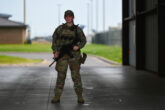December 01, 2016
Elephants in Afghanistan: The Military’s Counterinsurgency Failure
Earlier this year, several former ISAF commanders and diplomats wrote President Barack Obama, imploring him to freeze troop levels in Afghanistan until the next administration takes office. Obama ultimately agreed to keep 8,400 troops in country, but while President-elect Donald Trump said many things about many foreign policy during the election season, he gave few hints as to how he would handle the conflict. As the transition is underway, U.S. military planners are still grappling with building effective Afghan security forces — an effort that could take many more years, if not decades. Such an extended endeavor may be in order to secure U.S. interests in Afghanistan, but Trump would do well to ask a few questions of our military leadership before writing another blank check.
After all, our collective efforts under the leadership of those who signed the letter to Obama have left us, after 15 years of war, with muddled results at best. We have expended $64 billion to create a massive security force that shows an incredible willingness to fight but cannot hold off the Taliban, a force with a fraction of the resources. We have also plowed $113 billion into development projects with only reports of endemic corruption, waste, and inefficiency to show for it. Much has been written — some of it even commissioned by the military — about the larger failures of our post-9/11 strategy. Yet very little has been said about how the military’s approach to Afghanistan shaped, and ultimately limited, our overall strategy.
Read the full article at War on the Rocks.
More from CNAS
-
National Security Human Capital Program
Short SupplyExecutive Summary The U.S. military faces a critical challenge: Fewer young Americans are willing to serve, and fewer adults are encouraging them to do so. Because of delibera...
By Katherine L. Kuzminski & Taren Sylvester
-
National Security Human Capital Program
Defending the Army’s Command Assessment ProgramThe concept for CAP — developed during the first Trump administration — benefited from the guidance, input and oversight from the foremost scholar and practitioner on military...
By Katherine L. Kuzminski
-
National Security Human Capital Program
‘Women Don’t Just Achieve…They Excel’: Fmr. Marine Corps Attack PilotDr. Kyleanne Hunter, former Marine Corps attack pilot and CEO of Iraq & Afghanistan Veterans of America, says “women are the fastest growing group of veterans” and “the fastes...
By Dr. Kyleanne Hunter
-
National Security Human Capital Program
A Workforce Strategy for America’s Shipbuilding FutureThe future of American maritime dominance will not be determined solely by the number of ships launched or contracts signed, but rather by the strength and sustainability of t...
By Katherine L. Kuzminski & Laura Schmiegel




